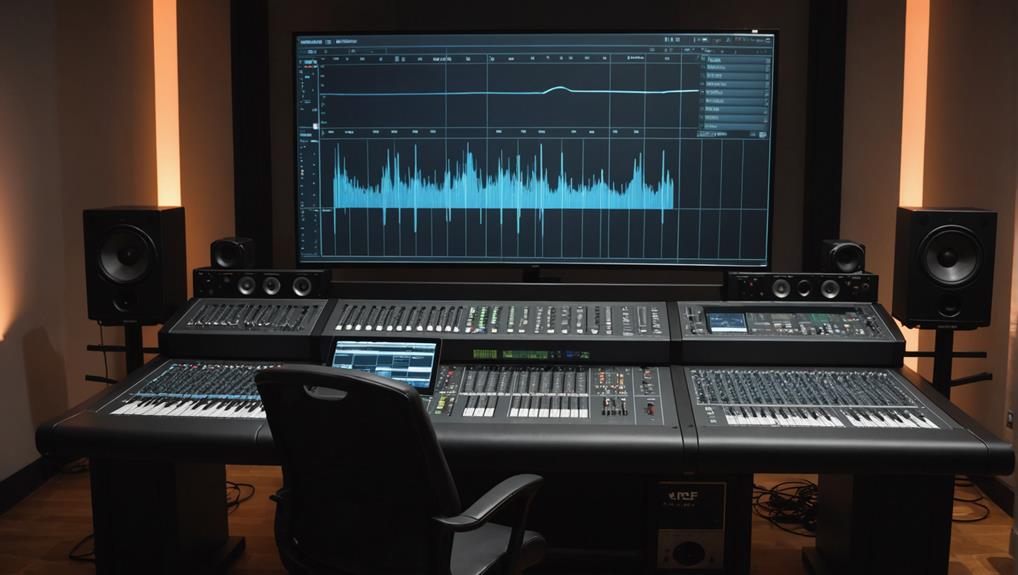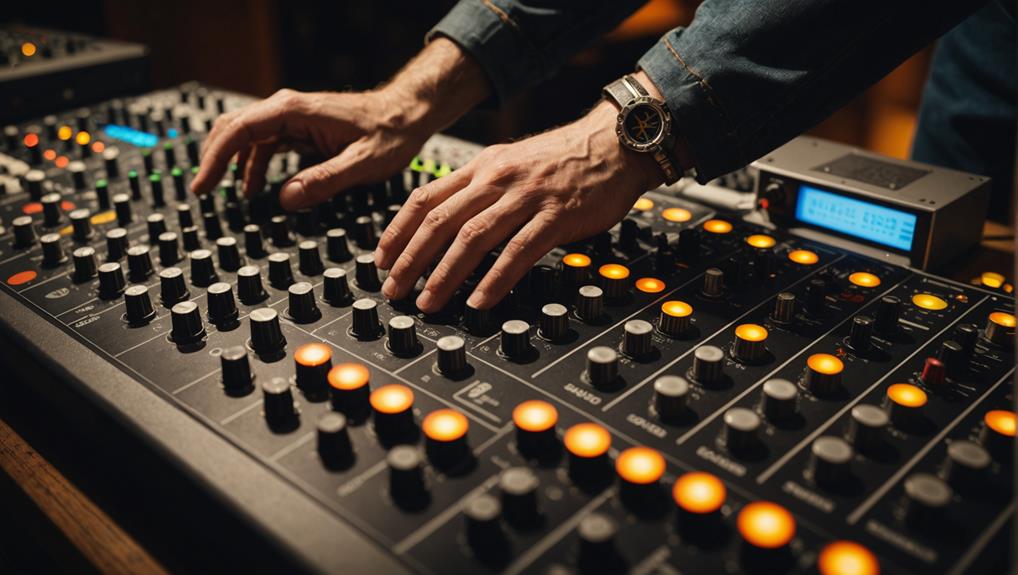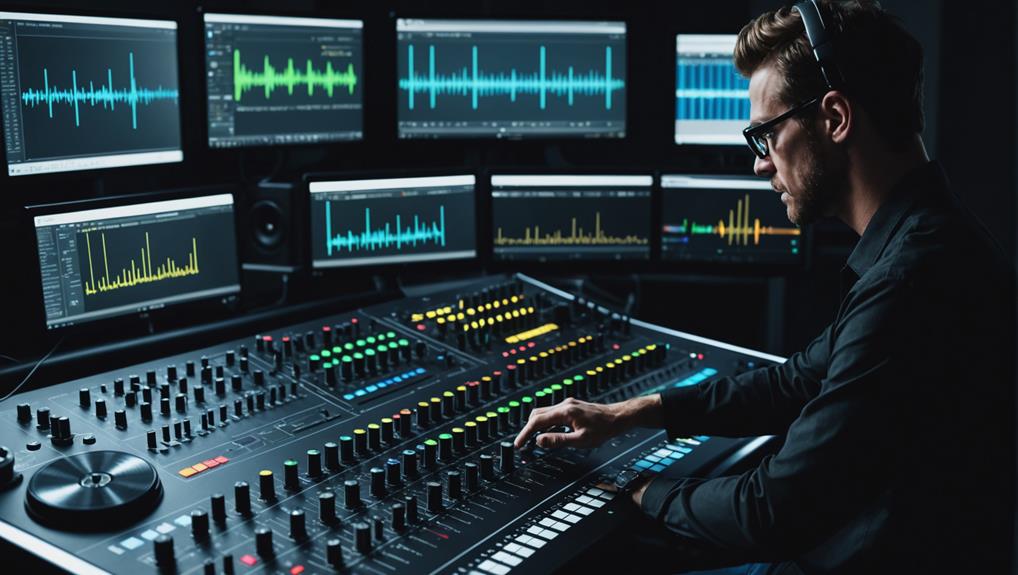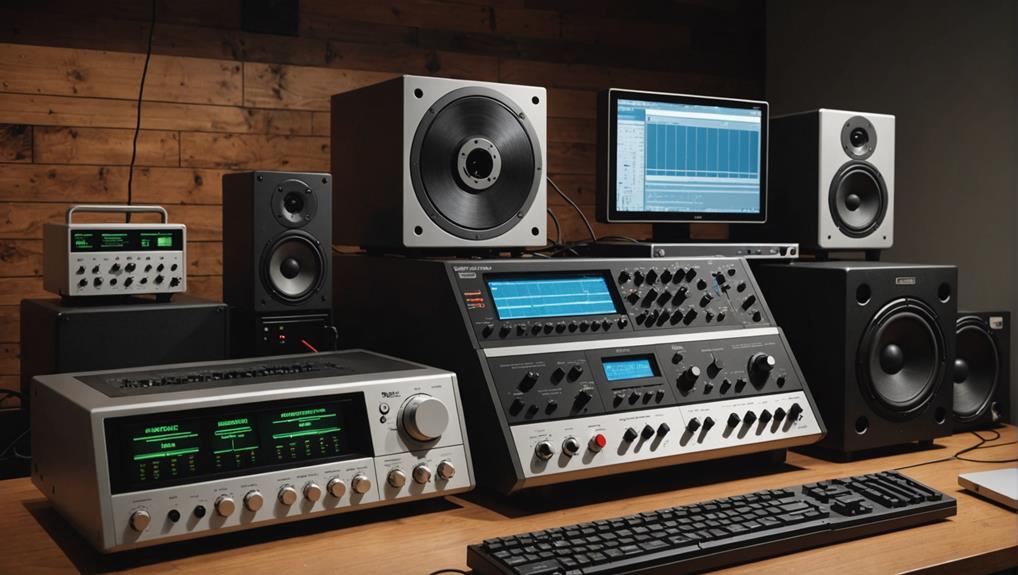Audio mastering is the final step in audio post-production, ensuring your tracks sound polished and consistent across all playback systems. You’ll focus on balancing levels, applying equalization, compression, and enhancing stereo imaging. Mastering makes your mix commercially viable, ready for formats like vinyl, MP3, and streaming. Using tools like iZotope’s Ozone, you’ll fine-tune dynamics and tonal balance, ensuring cohesive sound whether you’re using analog gear for warmth or digital plugins for precision. This meticulous process enhances clarity, depth, and impact, transforming raw mixes into professional projects. Keep exploring to master the art of achieving impeccable sound quality.
Key Takeaways
- Audio mastering is the final step in audio post-production, focusing on adjustments to levels, equalization, compression, and stereo enhancement.
- It ensures consistency and balance across various playback systems and distribution platforms.
- Mastering transforms raw mixes into polished, commercially viable tracks ready for different formats like vinyl, MP3, and streaming services.
- Essential tools include EQs, compressors, limiters, and precision monitoring systems.
- Mastering enhances sound quality by optimizing clarity, impact, and overall sonic balance for a professional standard.
Understanding Audio Mastering
Understanding audio mastering requires you to grasp the intricacies of fine-tuning a recording to guarantee it achieves peak playback quality across various formats and systems. The mastering process is the final step in audio post-production, focusing on meticulous adjustments to levels, equalization, compression, and stereo enhancement. It guarantees that your track sounds consistent and balanced, ready for distribution on vinyl, streaming platforms, radio, and TV.
Mastering software plays a vital role in this process. Tools like Ozone Advanced provide a suite of features that help you achieve professional-grade results. With its multiband compressors, dynamic EQs, and spectral shapers, Ozone Advanced allows you to sculpt the audio landscape with precision.
You’ll need to pay close attention to every detail, from the subtle boosting of high frequencies to enhance clarity, to the careful attenuation of low-end rumble that could muddy the mix.
Importance of Mastering
You can’t overstate the significance of mastering in audio production. It guarantees that your tracks achieve consistent playback quality and sound excellent across various formats and systems.
Enhances Sound Quality
How does audio mastering enhance a track’s sound quality to a professional level?
Mastering involves meticulous sound enhancement techniques that optimize a track’s overall clarity and impact. By adjusting levels, applying EQ, and utilizing compression, you can achieve a balanced mix that stands out. One of the primary mastering benefits is the significant quality improvement; it transforms raw mixes into polished, commercially viable tracks.
During the audio finalization stage, mastering engineers focus on creating a cohesive sound that translates well across various playback systems. They fine-tune the audio to make sure it sounds pristine on everything from high-end studio monitors to consumer earbuds. This meticulous attention to detail enhances the sonic characteristics and ensures that the final product is ready for distribution.
Moreover, mastering is essential for preparing music for different formats, including Vinyl, MP3, and streaming services. Each format has unique requirements, and mastering guarantees your track meets these specifications. This all-encompassing approach not only enhances the track’s sound quality but also ensures it maintains its integrity across various listening platforms.
Ultimately, mastering is the final, necessary step that brings your music to a professional standard.
Ensures Playback Consistency
Ensuring playback consistency, mastering meticulously aligns audio levels and tonal balance to guarantee your track sounds impeccable across all playback systems and formats. By employing precise sound optimization techniques, you secure that your music maintains superior playback quality whether it’s heard on high-end studio monitors, car speakers, or basic earbuds.
Mastering is essential for creating a polished, clean sound. It balances the audio dynamics, adjusts equalization, and manages compression levels to make certain that your track isn’t only loud enough but also clear and pleasant to the ear. This consistency enhances the listening experience, making your music ready for any distribution platform, from vinyl and MP3 to streaming services.
Consider the benefits of mastering:
- Smooth progression: Your track flows smoothly from start to finish without any jarring volume spikes or drops.
- Consistent sound: Every element of your mix is balanced, allowing for clarity and cohesion.
- Optimized distribution: Your music is optimized for various formats and platforms, ensuring it sounds great everywhere.
- Professional finish: A mastered track meets the industry standards required for commercial platforms like radio and TV.
In mastering, your track achieves the refined, consistent playback quality essential for a top-tier listening experience.
Mastering Vs. Mixing
Mastering’s role in audio production is distinct from mixing, focusing on refining the final stereo mixdown to achieve a polished, consistent sound across the entire project.
Mixing techniques involve balancing individual tracks within a song, adjusting levels, EQ, and effects to create a coherent soundstage. This part of the production workflow demands creative decisions on a track-by-track basis, guaranteeing each element of the song stands out or blends as intended.
In contrast, mastering takes the completed mix and enhances the overall sonic quality, dynamics, and tonal balance. Mastering engineers address the stereo mixdown, optimizing it with precise adjustments in EQ, compression, and limiting. This process ensures that the final product not only sounds cohesive but also maintains quality and consistency across all playback systems.
While mixing is about sculpting the individual elements of a song, mastering fine-tunes the entire project, making it ready for distribution.
A mastering engineer’s goal is to unify the album’s sound, making sure that each track flows seamlessly into the next. By focusing on the big picture, mastering enhances the album’s overall impact, providing a professional finish that stands up in the competitive music industry.
Mastering Equipment
For mastering, you’ll depend on essential tools like EQs, compressors, limiters, and meters to fine-tune your tracks.
High-quality DAWs and analog gear, such as tube amplifiers and tape machines, each bring unique qualities to your audio.
Precision monitoring systems, including studio monitors and headphones, guarantee you’re making informed, accurate decisions throughout the process.
Essential Mastering Tools
High-quality studio monitors, mastering-grade headphones, and a suite of analog and digital processors form the backbone of any professional mastering setup. To guarantee your mastering process achieves pristine audio quality, you’ll need an array of essential tools.
Specialized mastering software, like iZotope’s Ozone or Waves’ L3 Multimaximizer, provides you with a robust digital environment for precision editing. These programs offer a range of features, from dynamic processing to spectral shaping, integral to the mastering process.
Accurate monitoring is vital. Without it, even the best mastering software won’t protect you from poor acoustic decisions. Your setup should include:
- Studio Monitors: High-fidelity, flat-response monitors are essential.
- Mastering-Grade Headphones: For detailed listening sessions and double-checking mixes.
- Analog and Digital Processors: Compressors, equalizers, and limiters bring your tracks to life.
- Room Acoustics: Acoustically treated rooms ensure your sound is heard as intended.
Hardware processors, like tube equalizers and mastering consoles, add warmth and depth that digital tools might lack. Reference monitors and spectrum analyzers provide the analytical power needed to fine-tune audio content meticulously.
Every detail counts in the mastering process, and the right tools make all the difference.
Analog Vs. Digital Equipment
Deciding between analog and digital mastering equipment requires a keen understanding of their respective strengths and limitations. Analog gear, such as vintage compressors, EQs, and tape machines, is renowned for its analog warmth, adding a rich, characterful texture to audio. However, this warmth comes at a price—analog equipment tends to be expensive and demands regular maintenance to remain in top condition.
On the flip side, digital mastering equipment, including software plugins and digital processors, offers unparalleled digital precision. You can achieve meticulous control over every aspect of your audio, ensuring flexibility and recallability in your mastering workflows. Digital tools are often more cost-effective solutions, making them accessible to a broader range of engineers.
For those seeking the best of both worlds, hybrid setups provide excellent results by combining analog’s warmth and digital’s precision. This approach allows you to inject the unique sonic characteristics of analog gear while benefiting from digital’s efficient and versatile capabilities.
Ultimately, your choice between analog and digital mastering equipment will hinge on personal preference, the desired sonic qualities of your project, and budgetary constraints. Understanding these variables will guide you to the most suitable tools for achieving your mastering goals.
Mastering Techniques

Mastering techniques hinge on fine-tuning levels, EQ, compression, and limiting to enhance a mix’s overall sonic quality. During the mastering process, you make creative decisions that shape the final product. Mastering techniques are more than just technical steps; they’re an artistic expression that adds the final polish to your tracks.
Dynamic processing is key. Use compression to control the mix’s dynamic range, ensuring consistency without squashing its life. EQ adjustments help carve out frequencies, enhancing clarity and balance. Limiting is essential to maximize loudness while avoiding distortion. Maintaining proper headroom in the mix allows for these dynamic adjustments.
A few essential techniques to enhance your mastering:
- Reference Well-Mastered Tracks: Compare your mix with high-quality references to identify areas needing improvement.
- Experiment with Plug-Ins: Utilize various plug-ins to find the perfect combination for your project.
- Neutral Monitoring Environment: Use accurate monitors in a treated room to make precise adjustments.
- Rely on Skilled Ears: Trust your ears and intuition, blending technology with musical instinct.
Mastering is a delicate balance of technical expertise and artistic flair. By mastering these techniques, you can transform a good mix into an outstanding final product.
Pre-Mastering Preparation
Before diving into mastering, make sure your final mix is free of any clipping, distortion, or unwanted noise. Start by meticulously scrutinizing each track for any technical issues that could compromise the mastering process. Implement mixing tips such as using high-pass filters to eliminate unnecessary low-end rumble and employing spectral analysis to detect and resolve problematic frequencies.
In sound engineering, level consistency across your tracks is essential. Guarantee each track maintains a uniform tone and volume, avoiding drastic jumps that can disrupt the listener’s experience. Pay particular attention to the dynamic range, preserving enough headroom for the mastering engineer to work effectively without compromising the integrity of the mix.
Organize your tracks in the intended sequence for the final album or release. This not only aids in maintaining a coherent flow but also helps the mastering engineer understand the artistic narrative you’re aiming for.
Communicate clearly with your mastering engineer about your artistic preferences and goals for the final sound. Provide reference tracks if needed, to illustrate the sonic aesthetic you aspire to achieve.
Establishing Song Aesthetic

When you’re establishing the song’s aesthetic, start by defining its sonic character to guarantee it aligns with the artist’s vision.
You’ll need to balance tonal elements using EQs and compressors to achieve clarity and depth.
Defining Sonic Character
Establishing the sonic character of a track involves meticulously enhancing its clarity, warmth, depth, and impact to create a polished sound that truly reflects the artist’s vision.
When you’re defining sonic character, you’re focusing on the sonic qualities that give a song its unique flavor. This includes considering genre influence, as different genres demand distinct tonal attributes and dynamic ranges. Your goal is to guarantee the track resonates with its intended audience, forging an emotional connection and solidifying its sonic identity.
Mastering engineers employ a variety of techniques to achieve this. They adjust levels, frequencies, and stereo imaging to shape the sonic landscape. By addressing these elements, you align the track’s aesthetic with the artist’s vision, creating a cohesive and immersive listening experience.
Key aspects to evoke emotion in your audience include:
- Clarity: Ensuring each element in the mix is distinctly audible.
- Warmth: Adding harmonic richness to make the track feel inviting.
- Depth: Creating a sense of space that draws the listener in.
- Impact: Enhancing dynamics to make the track feel powerful and engaging.
Mastering’s precision and attention to detail are what ultimately define the sonic character, making each track an authentic representation of the artist’s intent.
Balancing Tonal Elements
To achieve a cohesive sound, you need to meticulously balance tonal elements by adjusting frequencies like bass, mids, and highs. This process, known as frequency adjustments, is vital for establishing the song’s aesthetic.
Begin by using equalization (EQ) tools to fine-tune the tonal balance. Your goal is to make sure that each frequency range complements the overall mix, enhancing both sonic cohesion and tonal clarity.
Start with the bass frequencies, ensuring they provide a solid foundation without overwhelming the mix. Adjust the mids to bring out the core elements of the track, such as vocals and key instruments, ensuring they remain prominent yet balanced. Finally, refine the highs to add brilliance and airiness without introducing harshness.
Depth enhancement is another critical aspect. By subtly boosting or cutting specific frequencies, you can add dimensionality to the mix, making it more immersive and engaging.
Pay close attention to how these adjustments affect the overall sonic landscape, aiming for a harmonious blend that enhances the music’s aesthetic appeal.
Enhancing Emotional Impact
Mastering engineers meticulously sculpt the sonic landscape to amplify the emotional impact, guaranteeing each element aligns with the artist’s intended aesthetic. By refining the song’s sonic characteristics, they evoke specific emotions that resonate deeply with the listener.
This process involves a combination of EQ, compression, and limiting to enhance the emotional connection and optimize the listener experience.
To achieve mood enhancement, mastering engineers focus on:
- Dynamics: Balancing the dynamic range to maintain the song’s energy and intensity.
- Tonal Quality: Adjusting frequencies to highlight the song’s emotional core.
- Spatial Imaging: Creating a sense of space that immerses the listener.
- Consistency: Ensuring the song flows seamlessly from start to finish.
Each adjustment is a careful artistic interpretation aimed at preserving the song’s authenticity while elevating its emotional resonance. The goal is to craft a final product where every element, from the deepest bass to the highest treble, contributes to the overall mood and impact.
Ensuring Album Consistency
Consistency in an album’s sound quality and tone is frequently achieved through meticulous audio mastering, which fine-tunes levels, EQ, and dynamics for a seamless listening experience. When you’re aiming for album cohesion and sonic consistency, mastering is key. It guarantees that each track’s volume, EQ, and dynamics align, creating a unified sound across the album.
Sound uniformity and track blending are essential for a professional, polished final product. Mastering addresses these by carefully adjusting each track to maintain a consistent volume level and sonic balance. This process allows tracks to merge smoothly, preventing any abrupt shifts that can disrupt the listener’s experience.
Here’s a breakdown of key elements in ensuring album consistency:
| Element | Purpose | Result |
|---|---|---|
| Levels | Balance volume across tracks | Consistent loudness |
| EQ | Adjust frequency balance | Cohesive tonal quality |
| Dynamics | Control dynamic range | Smooth progressions |
| Track Sequencing | Arrange tracks in logical order | Natural flow |
| Final Listening | Review entire album | Catch any inconsistencies |
Optimizing for Distribution

After achieving album consistency, the next step is optimizing your tracks for distribution across various formats like CD, vinyl, and streaming platforms. This phase guarantees that your music maintains consistent playback quality and sound characteristics, irrespective of the medium.
To achieve superior format compatibility, you’ll need to employ specific distribution strategies and optimization techniques. Start by adjusting levels, tonal balance, and dynamics to meet the technical requirements of each distribution format. For instance, vinyl mastering demands careful attention to low-frequency management to avoid groove distortion, while streaming platforms often require compliance with loudness standards like LUFS.
Here are key aspects to take into account:
- Format Compatibility: Guarantee your tracks sound great on every platform, from high-fidelity vinyl to compressed streaming services.
- Sound Characteristics: Preserve the integrity and quality of your music across various playback systems.
- Distribution Strategies: Tailor your mastering process to the specific demands of each distribution channel.
- Optimization Techniques: Apply precise adjustments to levels, EQ, and compression to achieve the best possible sound.
Mastering Examples
Ever wondered how mastering engineers achieve that polished, professional sound on your favorite tracks? The mastering process is a meticulous blend of art and science that involves fine-tuning levels, adjusting EQ, applying compression, and enhancing overall sound quality.
By examining sample tracks, you can see how these techniques bring out the best in each piece.
Take, for example, the use of Ozone Advanced. This tool is a staple in the mastering process, optimizing audio playback quality and guaranteeing consistency across different formats like Vinyl, MP3, and streaming services. Through mastering, tracks aren’t only prepared for diverse listening environments but also tailored to meet commercial distribution standards.
Mastering examples also highlight the importance of achieving a cohesive, balanced sound across an album or project. A well-mastered album ensures that each track maintains its individuality while contributing to the overall sonic experience.
The result is a unified body of work that sounds polished and professional, ready for any distribution platform.
Evolution of Mastering

Understanding how mastering engineers achieve a polished sound requires a look at the evolution of mastering techniques, starting from the mechanical processes of the pre-1940s and advancing through to today’s digital innovations. Initially, mastering was a purely mechanical process, with engineers manually adjusting grooves on vinyl records. This era laid the foundation for future advancements.
With the introduction of magnetic tape recording in the 1940s, the industry witnessed a seismic shift. This historical innovation allowed for precise edits and adjustments, transforming how engineers approached mastering. The 1950s to late 1970s saw electro-mechanical mastering dominate the scene. Engineers focused on fine-tuning sound amplitudes for peak playback, using equalizers and compressors to shape the audio landscape.
The 1990s brought another evolutionary milestone: digital technology. Digital Audio Workstations (DAWs) revolutionized the field, offering unparalleled control and precision. Today, mastering engineers leverage advanced algorithms and software to achieve pristine sound quality.
Consider these milestones in audio mastering:
- Mechanical mastering: The tactile art of groove adjustments.
- Magnetic tape: Precision editing and sound shaping.
- Electro-mechanical techniques: Fine-tuning with equalizers and compressors.
- Digital revolution: Advanced DAWs and algorithmic enhancements.
These evolutionary milestones highlight the relentless pursuit of audio perfection.
Learn More About Mastering
Mastering, the final frontier of audio production, demands meticulous attention to detail to guarantee your tracks sound impeccable across all playback platforms. The mastering process involves a series of precise adjustments including level balancing, equalization, compression, and limiting. Each of these elements ensures your audio maintains consistency, clarity, and balance, ultimately aligning with industry standards.
By engaging in the mastering process, you’re not only refining the sonic qualities of your music but also optimizing it for diverse playback formats such as CDs, vinyl, streaming services, and radio broadcasts. This step is essential in making certain that your tracks sound their best, regardless of where they’re played.
Mastering benefits are manifold. It enhances the listening experience by preserving the artist’s original vision while making subtle improvements that enhance the audio quality. Mastering engineers employ specialized tools and techniques, fine-tuning every detail to perfection. This professional touch ensures that your music can compete with commercial releases, providing a polished, cohesive sound.
Understanding the intricacies of mastering empowers you to appreciate its important role in music production. By delving into this final stage, you guarantee your tracks achieve their full potential, resonating with audiences across all platforms.
Frequently Asked Questions
What Does Audio Mastering Do?
You’ll enhance the dynamic range and stereo imaging during audio mastering, ensuring your tracks have consistent sound quality, volume, and tonal balance. Mastering refines your mix, preparing it for various distribution formats and a professional release.
What Is the Point of Mastering?
Mastering guarantees consistency across playback platforms, enhances sound quality, and maintains artistic integrity. Analog mastering, with its rich history, provides warmth and depth, making tracks commercially viable for radio, TV, streaming, and physical formats.
Does Mastering Improve Sound Quality?
Mastering definitely improves sound quality. You optimize loudness, balance frequencies, and enhance dynamics. This precision guarantees your track is consistent, polished, and impactful across various playback systems, making it sound more professional and engaging.
What Is Mastering Vs Mixing Audio?
Mixing balances individual tracks, while mastering focuses on the final mix’s overall sound. Mastering engineers use specialized equipment like EQ, compression, and limiting to guarantee top-notch playback quality across different formats, preserving the artist’s vision.
Conclusion
Mastering is the final, pivotal step in audio production, guaranteeing your tracks are polished, balanced, and ready for distribution.
Unlike mixing, which focuses on individual elements, mastering enhances the overall sound using specialized equipment and techniques.
By understanding its importance and staying updated with evolving practices, you’ll secure that your music competes in a professional landscape.
Delve deeper into mastering to enhance your audio projects, making sure they meet industry standards and captivate your audience.

